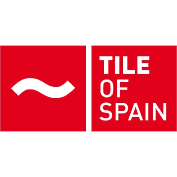My trip to Spain was definitely one for the books, incredibly educational and so much fun! Thank you Tile of Spain!
After enjoying several days in Bologna, Italy at Cersaie, the second portion of my personal Tile Tour took me to several cities in Spain with Coverings co-sponsor, Tile of Spain, where I discovered new products, trends in manufacturing, tile research and some of the most iconic and historic tile designs I’ve ever seen. Check out the sights and scenes from my trip, and a little preview of what you can expect to see from Spanish exhibitors at Coverings 2015:
Barcelona, Gaudi, and More Hexagon Tiles!
I had the chance to spend the weekend in Barcelona, and at top of my list was to tour all of the amazing Antoni Gaudi architecture around the city. The first thing I noticed as I wandered down Passeig de Gracia was the beautiful hexagon tiles that paved the street — one of the city’s tributes to Gaudi. The tiles are a replica of the original mosaics he produced. After seeing so many of this particular scale of hexagon tiles at Cersaie, it was interesting to note that the iconic pattern also reflects the historic architecture and design in Spain, thanks to Gaudi. Today, the style continues to be trending and very relevant in modern architecture and design. The hexagon is here to stay!
During my explorations, I visited many of Gaudi’s great works — Park Guell, Casa Batlló, La Sagrada Familia, and Casa Milá. The way he incorporated ceramics into his installations—from structural to ornamental — was brilliant. Perhaps most impressive was the interior atrium of Casa Batlló, where there was a beautiful gradient of shades of blue ceramic tiles, several stories high. I had seen so much of his work in photos before, but nothing was like the experience of seeing it in person. The nearly 150-year-old architecture proves that tile can create a truly breathtaking design statement that stands the test of time.
These amazing hexagonal tiles lined the streets of Barcelona as a tribute to Antoni Gaudi. I love that hexagon translates from historic architecture to modern design.
Castellón
After Barcelona, it was time to head to Castellón, where I spent the next two days touring tile factories, visiting the Instituto de Tecnologia Ceramica (ITC), and learning about the city and culture.
During this portion of the trip, I had a wonderful host, Eva Pedrajas from ASCER, the Spanish Ceramic Tile Manufacturers Association. A native of Castellon, she gave me a rich history of the area as well as the industry. Together we visited the factories of VIVES, NATUCER, and NEOLITH/The Size. It was interesting seeing first-hand the different types of manufacturing each factory used. To cite just a couple examples, NATUCER uses an extrusion process to manufacture their tiles. Extrusion manufacturing uses a wetter, more malleable clay which is forced through a mold to create its form, and then fired at high temperatures where as dry press manufacturing of tile presses the tile into its shape. This process allows them to create many of the unique, 3-Dimensional shapes of their products. The easiest way to picture the extrusion process is perhaps comparing it to how a cookie press works when baking. The dough gets put into the press, where you use a plate with the cutout of the shape you want, press the dough out to create the cookie form, and then cut it into size. They also use Roto Color technology (where tile designs are pressed into the tiles using large roller) like most tile manufacturers, so they can screen print extruded tile. During my visit to the factory at Vives, they were producing beautiful wood porcelain tiles through digital printing process, one of the most innovative techniques in the modern manufacturing of ceramic tile.
After a full day of tile factory touring we stopped for an alfresco lunch at the port of Castellón, where I had the most authentic paella I’ve ever tried!
The ITC
My second day in Castellón began with a visit to the Instituto de Tecnologia Ceramica, a facility that plays a key role in assisting with the needs of tile manufacturing companies in the Spanish Ceramic sector. Their lab and facilities conduct all sorts of product testing, as well as development and research to improve innovation and provide solutions to make superior products at an improved cost structure. The first portion of the visit we toured some of the labs and saw many of the different types of product testing and research they offer to Spanish ceramic companies. This included a demo in Pendulum slip testing, which was performed with a Pendulum, where a piece of rubber is mounted to the pendulum itself, and measurements are taken as it strikes the tile being tested to determine slip resistance. We also saw some of the other equipment used to test other slip resistance— one which interestingly included a treadmill on an incline, and a pair of sneakers sitting beside it. I wish I could have watched that test, as it looked quite intriguing! I also learned about how they can address any problems the manufacturing companies face and collaborate with them to generate new technology. This could include anything from new coatings and surface treatments to environmental technologies. The ITC also offers marketing consulting and extensive trend analysis for the companies they work with.
This tour was very interesting to me as a designer because I was able to see all of the testing and technology that goes into not only creating safe tile products, but the most innovative products as well. In my sector of the industry we typically only see the end result of all of this, so I enjoyed seeing just how much research goes into creating the tiles I specify.
The sights and scenes of the tile factories in Castellón – it was meaningful and exciting to see how much work goes into the tiles I use everyday.
Last Stop…Valencia
After learning and seeing all of the fascinating things the ITC has to offer Spanish ceramic companies, there was one last stop…the city of Valencia. We took a quick train ride from Castellón, and the very first thing I noticed at the train station in Valencia was the exquisite mosaic tile ceiling. On my tour of the city, I saw a lot of the notable architecture and sampled some of the local cuisine.
My trip to Spain was absolutely truly educational. I enjoyed learning about the ceramic industry with Tile of Spain, seeing how the culture influences tile production and design, and all of the brilliant and historic uses of ceramics in the architecture.
I must say my Tile Tours of Italy and Spain were incredible – and a special thanks to Tile of Spain and Ceramics of Italy for this memorable experience. I’m now looking forward to attending Total Solutions Plus in San Antonio, TX, and continuing to report back my experiences and insights from the tile and stone industries.






